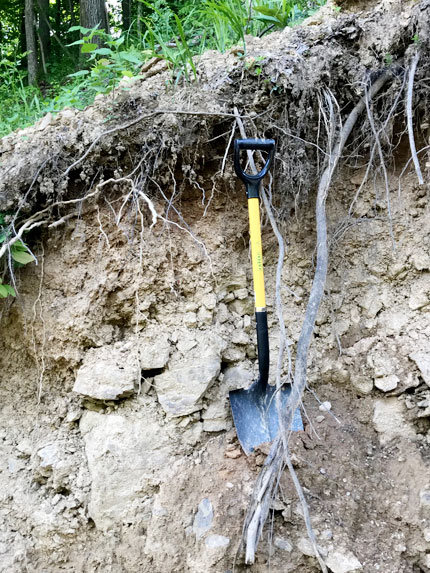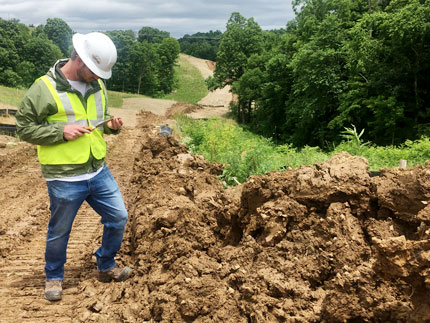Soil Science Society of America
5585 Guilford Road • Madison, WI 53711-5801 • 608-273-8080 • Fax 608-273-2021
www.soils.org
Twitter | Facebook
NEWS RELEASE
Contact: Hanna Jeske, Associate Director of Marketing and Brand Strategy, 608-268-3972, hjeske@sciencesocieties.org
More data, more land reclamation success
Feb. 13, 2019 - More than 2.4 million miles of energy pipelines crisscross the United States. If assembled end-to-end, they would circle the Earth almost 100 times!
 Energy pipelines transport products such as crude oil or natural gas. Some of the pipelines are above ground, but most of them are buried. Often, energy pipelines pass through previously undisturbed areas. These areas need to be managed carefully to re-establish ecologically functioning systems. This complex process is called land reclamation.
Energy pipelines transport products such as crude oil or natural gas. Some of the pipelines are above ground, but most of them are buried. Often, energy pipelines pass through previously undisturbed areas. These areas need to be managed carefully to re-establish ecologically functioning systems. This complex process is called land reclamation.
A new study shows teams can increase the chance of successful land reclamation by first collecting soil data at short intervals. More collections can also lead to significant cost savings.
The study focused on a 170-mile length of natural gas pipeline in West Virginia. The land reclamation plan was to re-establish previously forested areas as a grassy, low-growth system.
Initially, all 170 miles had the same, standard reclamation plan based on more generic soil information. “But we know that soils can vary on a mile-to-mile basis,” says James Hartsig, a scientist at Duraroot, LLC in Keenesburg, CO.
The team of scientists gathered more soil data. They collected approximately 350 soil samples along the pipeline. Samples were collected every half-mile.
These samples were sent to accredited laboratories. There, technicians identified critical chemical and physical soil characteristics. “There were initially no sampling efforts involved in the project. We brought sampling efforts to the project for increased and accelerated vegetation. These soil fertility assessments helped us make more nuanced recommendations,” says Hartsig.
One area of focus was soil pH levels–a measure of soil acidity.
“Soil pH values are critical for several reasons,” says Hartsig. For example, soil pH helps determine nutrient availability for plants. Most plants prefer pH values between 5.5 and 7.
But getting a handle on soil pH values can be challenging, says Hartsig. Soils often have different pH values even within a mile. With data points every half-mile, the scientists could overcome these challenges. Throughout the site, pH values ranged from 4.5 to 8.5.
Typically, lime is added to soils to bring the pH within the desired range. Along the West Virginia pipeline, the standard recommendation was to add two tons of lime per acre of soil. But, based on the soil fertility assessments, Hartsig and colleagues had a more specific plan. They recommended no lime for almost half the pipeline. They also recommended three tons per acre for another quarter of the pipeline.
The team also fine-tuned how much fertilizer to add.
 “We found that applying the appropriate amount of lime and fertilizer leads to faster revegetation efforts,” says Hartsig. “Plus, there’s no need to go back to certain areas for re-application.”
“We found that applying the appropriate amount of lime and fertilizer leads to faster revegetation efforts,” says Hartsig. “Plus, there’s no need to go back to certain areas for re-application.”
Not having to reapply lime or fertilizer can be a big cost saver. That’s especially true in the mountainous areas of West Virginia where application processes can be very expensive.
These findings can improve land reclamation success in states other than West Virginia as well. “Regardless of geographical setting, these types of assessments can provide much better insight into soil properties,” says Hartsig. That’s key, especially for longer pipelines. In fact, “the longer the pipeline alignment, the better the chances that the standard specification will be refined.”
Hartsig and colleagues are continuing to research ways to enhance land reclamation. “We are currently testing different types of lime and fertilizers,” he says. “We are also exploring different application methods.” This could include drill seeding with fertilizer injections, broadcast seeding with fertilizer and lime, or aerially applying seed or fertilizers.
Ultimately, says Hartsig, the goal is to accelerate land reclamation success.
Hartsig presented these findings during the International Meeting of the Soil Science Society of America in San Diego, Jan. 6-9.